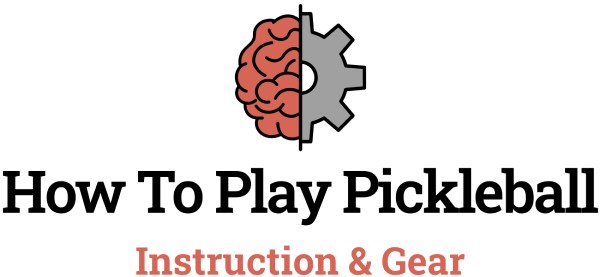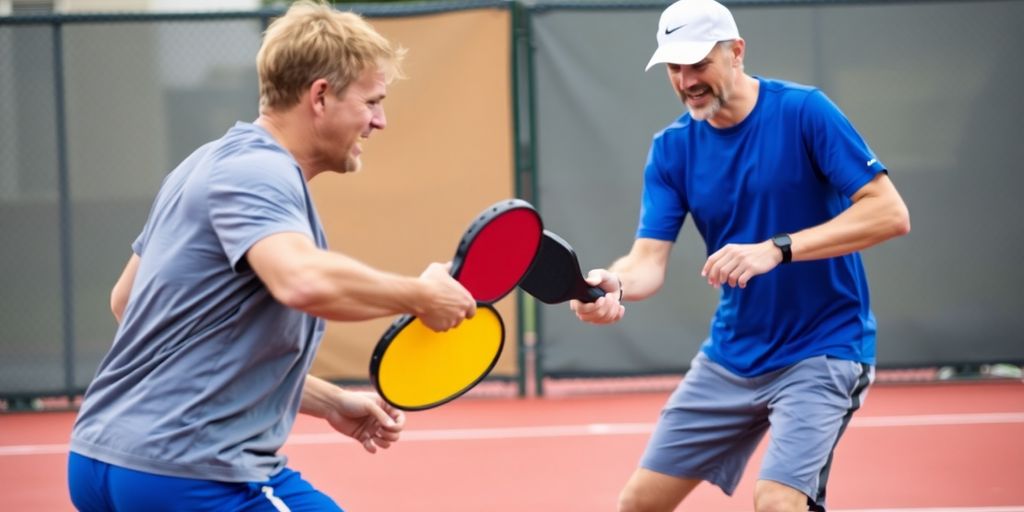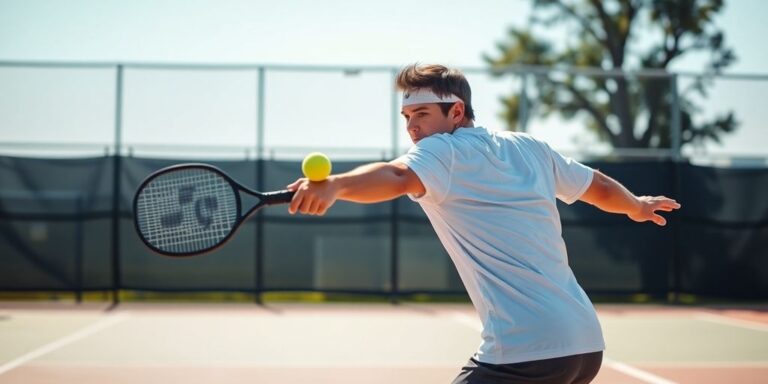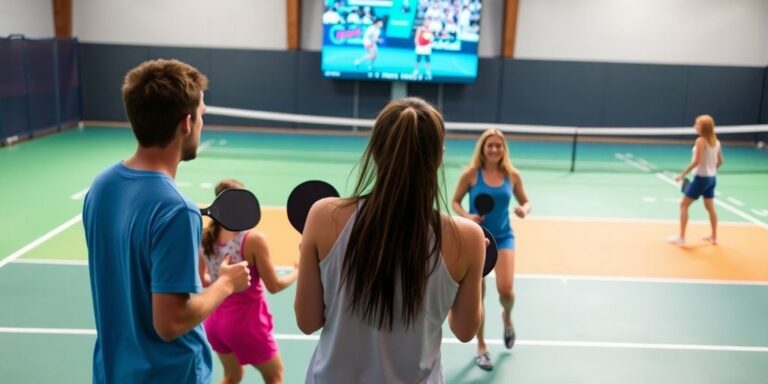Pickleball is a fun and fast-growing sport, and understanding the different skill levels can really help players improve and enjoy the game more. The skill rating system ranges from 2.0 for absolute beginners to 5.0+ for seasoned pros. Knowing where you fit in this scale can make a big difference in how you play, who you play against, and how you progress. This guide will break down pickleball levels and give you a clearer picture of what each rating means.
Key Takeaways
- Pickleball skill ratings range from 2.0 to 5.0+, indicating players’ abilities.
- Beginners (2.0-2.5) are just starting and learning the basics of the game.
- Intermediate players (3.0-3.5) start developing strategies and improving shot consistency.
- Advanced players (4.0-4.5) show strong control and competitive skills in matches.
- Experts (5.0+) have mastered the game and often compete at high levels.
Understanding The Pickleball Skill Rating System
Overview of Skill Ratings
Pickleball uses a rating system to show a player’s skill. It’s how you know where you stand and who you should be playing with. The ratings usually go from 2.0 for beginners all the way up to 5.0+ for pros. It’s not just about winning or losing; it’s about playing at a level that helps you get better and have fun. Think of it like levels in a video game – you want to level up, right?
- Ratings help you find suitable opponents.
- They guide tournament placements.
- Ratings offer a way to track your progress.
Understanding the pickleball players’ rating is important for both your own growth and for playing competitively. It helps you understand where you are and what you need to work on.
Importance of Knowing Your Level
Knowing your pickleball level is super important. It’s not just an ego thing. It helps you find games that are actually fun and challenging, not frustrating. If you’re a 2.5 playing against 4.0s, you’re probably not going to have a good time. Plus, it helps you set realistic goals for improving your game. Are you trying to reach the basic pickleball rules level? Or are you aiming higher?
- Ensures fair and competitive matches.
- Helps in setting realistic goals.
- Prevents mismatches that can be discouraging.
How Ratings Are Determined
So, how do they figure out your rating? It’s not just random. It’s based on a bunch of things, like your serves, volleys, dinks, and smashes. They also look at where you are on the court, how well you move, and if you can guess what your opponent will do. It’s not just about hitting the ball; it’s about strategy and how well you play the game. Also, your mental game matters. Can you stay focused? Can you change your plan when things get tough? Communication is key in doubles, and that counts too. Ratings are always changing based on how you play in matches and tournaments. This way, your rating shows how good you are right now.
| Skill | Description
Beginner Pickleball Levels
2.0 Level Players
Okay, so you’re at the 2.0 level in pickleball. What does that even mean? Well, it means you’re past the stage of just figuring out which end of the paddle to hold. You know the basic rules and can keep a short rally going… sometimes. You can probably serve the ball in bounds most of the time, which is a big win! But let’s be real, your strategy might be non-existent, and court positioning? Still a mystery. You’re starting to recognize your weaknesses, though, and that’s a huge step. Net play is probably still a bit scary, but you’re getting there.
2.5 Level Players
Alright, 2.5 players, you’re moving up in the world! You’re not just hitting the ball; you’re starting to aim (sort of). You can maintain longer rallies than the 2.0 folks, and those easier volleys? You’re making them more often. Backhand shots are creeping into your game, even if they’re not always pretty. You’re starting to grasp the idea of dinks and lobs, even if you don’t always execute them perfectly. You might even be thinking about joining a local pickleball league to get some real game experience.
Common Characteristics of Beginners
So, what ties all beginners together? What are those common threads that link the 2.0 and 2.5 players (and even those just starting)?
- Learning the rules is still a work in progress. You might need a quick refresher now and then. Understanding pickleball skill ratings is also part of the learning curve.
- Consistency is your enemy. Some days you’re hitting winners, other days you’re hitting the fence.
- Strategy? What strategy? You’re mostly just trying to hit the ball back over the net.
- Footwork is… well, let’s just say there’s room for improvement. You’re probably standing flat-footed a lot.
- You’re making unforced errors all the time. Hitting the ball out or into the net is a common occurrence.
The most important thing at the beginner level is to have fun and keep playing. Don’t get discouraged by mistakes. Everyone starts somewhere, and the more you play, the better you’ll get. Focus on developing a solid foundation of basic skills, and the rest will come with time. Consider getting some tips for mastering pickleball to accelerate your progress.
Intermediate Pickleball Levels
3.0 Level Players
At the 3.0 level, you’re moving beyond the basics. Players at this level demonstrate more consistency in their shots and are developing a better understanding of strategy. You’re likely hitting more serves in, sustaining longer rallies, and starting to use the non-volley zone (NVZ) more effectively. You’re also beginning to understand the importance of the third shot drop. You can usually place shots with moderate accuracy, but still struggle with consistency under pressure. You’re also starting to recognize your own weaknesses and are actively working to improve them. You’re probably playing in recreational games regularly and might even be considering entering a local tournament. You are starting to understand pickleball strategy.
3.5 Level Players
Players at the 3.5 level show a marked improvement in consistency and strategy. You’re now able to execute a wider range of shots with greater accuracy, including dinks, volleys, and overheads. Your serves are more reliable, and you’re starting to add spin to your shots. You’re also developing better court awareness and can anticipate your opponent’s moves more effectively. You are likely playing in competitive games and tournaments, and are actively seeking ways to improve your game. You are probably looking for pickleball clubs to join.
- Better shot placement and consistency.
- Improved court awareness and anticipation.
- More strategic play, including third shot drops and dinking.
Players at this level are becoming more strategic in their shot selection and court positioning. They are also developing a better understanding of the mental aspects of the game, such as managing pressure and staying focused.
Skills Development at This Stage
This is a crucial stage for skill development. Players should focus on improving their consistency, shot selection, and strategic play. This includes mastering the third shot drop, developing a reliable dinking game, and learning to control the pace of play. Working on your pickleball serve is also important. Drills that focus on consistency and accuracy are essential, as well as match play to develop strategic thinking and decision-making skills. Consider taking lessons from a certified instructor to get personalized feedback and guidance. It’s also a good time to start analyzing your own game and identifying areas for improvement. This might involve recording your matches and reviewing them, or simply paying closer attention to your strengths and weaknesses during play.
Advanced Pickleball Levels

4.0 Level Players
At the 4.0 level, you’re not just playing pickleball; you’re actively strategizing and executing plays with a high degree of consistency. Players at this level demonstrate reliable control over their shots, blending power and finesse effectively. They understand court positioning, anticipate opponent moves, and can adapt their game based on the situation. You’ll see them using spin effectively, controlling depth, and placing shots strategically to gain an advantage. They are also able to force errors when serving.
- Consistent and dependable strokes, including directional control and depth on both forehand and backhand shots.
- Reliable serves, lobs, overheads, approach shots and volleys and can use spin shots with some success.
- Demonstrates 3rd shot strategies – drop shots, lobs, and fast-paced ground strokes.
Players at this level are often seen competing in local tournaments and leagues, showcasing their ability to maintain composure under pressure. They understand the importance of teamwork in doubles and communicate effectively with their partners.
4.5 Level Players
Stepping up to 4.5 means you’re a serious contender on the pickleball court. These players possess a wide range of shots and can execute them with precision and power. They have mastered the soft game, including dinking and dropshots, but can also switch gears to aggressive drives and volleys. Their footwork is exceptional, allowing them to cover the court efficiently and react quickly to their opponent’s shots. They are able to sustain dinking in the game and demonstrate more strategies of playing during games. This player works better with partners in communicating, covering court, moving to net. At this level, pickleball players are beginning to develop strategic awareness, often thinking two or three shots ahead.
- Mastery of all basic strokes, including dinks, dropshots, volleys, and drives.
- Exceptional footwork and court coverage.
- Ability to adapt strategy based on opponent and game situation.
Strategies for Competitive Play
At the advanced levels, strategy becomes just as important as skill. It’s not enough to simply hit the ball well; you need to outthink your opponents. This involves understanding their weaknesses, exploiting their tendencies, and controlling the pace of the game. Here are some key strategies for competitive play:
- Varying Shot Selection: Mix up your shots to keep your opponents guessing. Use a combination of dinks, dropshots, drives, and lobs to disrupt their rhythm and force errors.
- Controlling the Net: The team that controls the net often controls the game. Work with your partner to establish a strong presence at the net and put pressure on your opponents.
- Effective Communication: Communication is key in doubles. Talk to your partner about strategy, positioning, and potential threats. A well-communicating team can anticipate their opponents’ moves and react accordingly.
Expert Pickleball Levels
5.0 Level Players
At the 5.0 level, you’re not just playing pickleball; you’re practically conducting an orchestra on the court. These players possess a mastery of all the fundamental shots and can execute them with impressive consistency and precision. They’ve moved beyond simply hitting the ball and are now dictating the pace and direction of play with strategic shot placement and well-disguised intentions.
- They exhibit exceptional court awareness, anticipating their opponent’s moves and positioning themselves for optimal returns.
- Their dinking game is refined, with the ability to control the height, speed, and angle of each shot.
- They demonstrate a high level of mental toughness, remaining calm and focused under pressure.
Players at this level are often highly competitive and participate in tournaments at the regional or national level. They are constantly seeking ways to improve their game, whether through focused practice, strategic analysis, or seeking guidance from experienced coaches. They understand the nuances of the game and can adapt their strategies to exploit their opponent’s weaknesses.
5.5+ Level Players
This is where pickleball transcends from a sport to an art form. Players at the 5.5+ level are the elite, the cream of the crop, the ones you watch in awe as they effortlessly glide across the court. These are often professional players or those with aspirations of turning pro. Their game is characterized by power, finesse, and an uncanny ability to read their opponents. They have mastered all aspects of the game, from serves and returns to dinks and volleys, and can execute them with remarkable consistency and precision. They are also adept at pickleball singles play, showcasing exceptional strategic depth.
- They possess exceptional hand-eye coordination and lightning-fast reflexes.
- Their footwork is impeccable, allowing them to cover the court with ease and efficiency.
- They demonstrate a deep understanding of game strategy and can adapt their play style to any opponent or situation.
Traits of Elite Players
What separates the 5.0+ players from the rest? It’s not just about physical skill; it’s a combination of factors that contribute to their dominance on the court. These players possess a unique blend of physical prowess, mental fortitude, and strategic acumen. They are students of the game, constantly analyzing their own performance and seeking ways to improve. They are also highly competitive, with a burning desire to win. The future of pickleball is bright, and these players are leading the charge.
- Unwavering Focus: The ability to maintain concentration and composure under pressure.
- Strategic Thinking: A deep understanding of game strategy and the ability to anticipate their opponent’s moves.
- Adaptability: The capacity to adjust their play style to different opponents and situations.
How To Assess Your Pickleball Level
It’s tough to know exactly where you stand in pickleball. Are you a beginner who’s just figuring out the kitchen line, or are you ready to dominate the local courts? Figuring out your skill level is important for fair games and to track your progress. Here’s how to get a handle on where you are.
Self-Assessment Techniques
Okay, so you want to figure out your level on your own? Start by being honest with yourself. Think about what you can consistently do, not just the amazing shots you pull off once in a blue moon.
Here are some things to consider:
- Can you consistently serve the ball in bounds?
- Are you comfortable dinking? Can you keep the ball low over the net?
- Do you understand the basic strategy of moving as a team?
- How often do you make unforced errors (hitting the ball out, into the net, etc.)?
It’s easy to overestimate your abilities, especially when you’re having a good day. Try to think about your average performance, not your best. Consider filming yourself playing a game. It can be eye-opening to see your strengths and weaknesses on video.
Using Online Tools
There are some online resources that can help you get a general idea of your level. These usually involve answering questions about your skills and experience. Keep in mind that these tools are not perfect, but they can be a good starting point. You can also use these tools to find suitable pickleball equipment.
Seeking Feedback from Coaches
This is probably the most accurate way to determine your pickleball level. A coach can watch you play and give you an objective assessment. They can identify areas where you need to improve and give you specific drills to work on. Many clubs offer skill assessments where experienced players or coaches evaluate your abilities during gameplay. This is a great way to get personalized feedback and a more accurate rating. This is especially helpful for seniors who want to stay active and socialize through pickleball.
The Importance of Pickleball Ratings

Pickleball ratings are more than just numbers; they play a big role in making the game fair and fun for everyone. It’s about finding the right competition and seeing how far you’ve come. Let’s get into why these ratings matter.
Matching Players for Fair Play
Pickleball ratings are key to creating balanced matches. Imagine a beginner playing against a seasoned pro – it wouldn’t be much fun for either of them. Ratings help organizers group players of similar skill, leading to more competitive and enjoyable games. This way, everyone gets a good workout and a fair shot at winning. It’s all about finding your level and playing with others who are at a similar stage in their pickleball journey. This is especially important in tournaments, where DUPR enhances pickleball by ensuring fair competition.
Tracking Progress Over Time
Ratings aren’t just for matching players; they’re also a great way to see how you’re improving. As you play more, learn new skills, and refine your strategy, your rating should go up. This provides a tangible measure of your progress and can be really motivating. It’s like having a report card for your pickleball game, showing you where you excel and where you might need to focus your efforts. Think of it as a pickleball rating that shows your skill level.
Enhancing Competitive Experience
For those who love the thrill of competition, ratings are essential. They determine your seeding in tournaments, ensuring you face opponents who are appropriately challenging. This makes the competitive experience more rewarding and helps you push your limits. Plus, a good rating can open doors to higher-level tournaments and even professional play. It’s all part of the journey of maintaining your pickleball gear and improving your game.
Ratings help to create a more enjoyable and competitive environment for all players. They ensure that matches are fair, provide a way to track personal progress, and enhance the overall experience of playing pickleball. Understanding and respecting the rating system is key to getting the most out of the sport.
Understanding pickleball ratings is really important for players. They help you see how well you play and find the right matches. If you want to improve your game or just learn more about ratings, check out our website for tips and resources!
Wrapping It Up
So, there you have it! Understanding pickleball skill ratings isn’t just for the pros; it’s a handy tool for everyone, whether you’re just starting or looking to compete. Knowing your level helps you find the right opponents and challenges, which can make your game more fun and rewarding. Plus, as you improve, you can see how your rating changes, which is pretty motivating. Remember, everyone starts somewhere, and with practice, you can move up the ranks. So grab your paddle, hit the court, and enjoy the game!
Frequently Asked Questions
What is the pickleball skill rating system?
The pickleball skill rating system helps players understand their skill level, ranging from 2.0 for beginners to 5.0+ for advanced players.
How do I know my pickleball rating?
You can assess your rating by evaluating your skills, taking online tests, or getting feedback from coaches.
Why is it important to know my pickleball level?
Knowing your level helps you find players of similar skill, ensuring fair and enjoyable matches.
What are the characteristics of a beginner player?
Beginner players (2.0-2.5) are just learning the rules, have basic skills, and often struggle with consistency.
What skills do intermediate players develop?
Intermediate players (3.0-3.5) work on shot variety, positioning, and strategy to improve their game.
What defines an advanced pickleball player?
Advanced players (4.0-4.5) show strong control, strategic thinking, and can compete effectively in matches.




